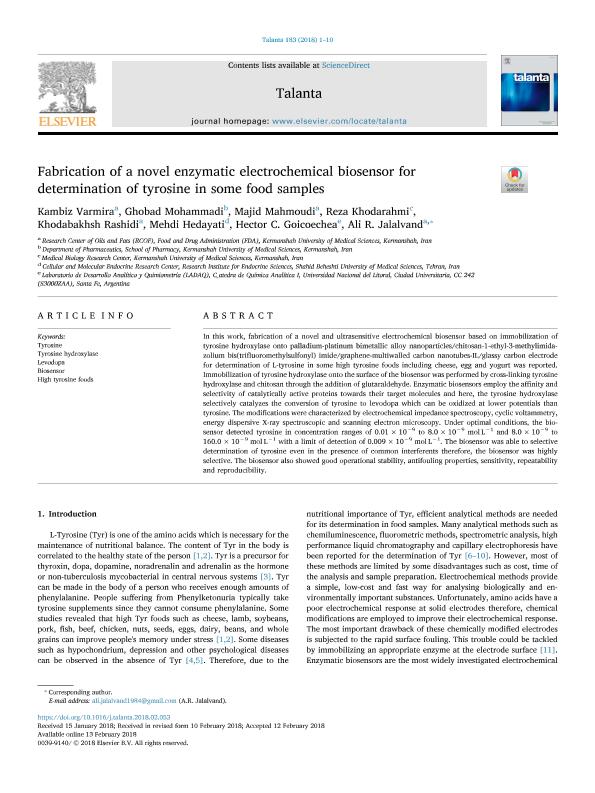Mostrar el registro sencillo del ítem
dc.contributor.author
Varmira, Kambiz
dc.contributor.author
Mohammadi, Ghobad
dc.contributor.author
Mahmoudi, Majid
dc.contributor.author
Khodarahmi, Reza
dc.contributor.author
Rashidi, Khodabakhsh
dc.contributor.author
Hedayati, Mehdi
dc.contributor.author
Goicoechea, Hector Casimiro

dc.contributor.author
Jalalvand, Ali R.

dc.date.available
2019-11-19T22:45:22Z
dc.date.issued
2018-06
dc.identifier.citation
Varmira, Kambiz; Mohammadi, Ghobad; Mahmoudi, Majid; Khodarahmi, Reza; Rashidi, Khodabakhsh; et al.; Fabrication of a novel enzymatic electrochemical biosensor for determination of tyrosine in some food samples; Elsevier Science; Talanta; 183; 6-2018; 1-10
dc.identifier.issn
0039-9140
dc.identifier.uri
http://hdl.handle.net/11336/89243
dc.description.abstract
In this work, fabrication of a novel and ultrasensitive electrochemical biosensor based on immobilization oftyrosine hydroxylase onto palladium-platinum bimetallic alloy nanoparticles/chitosan-1-ethyl-3-methylimidazolium bis(trifluoromethylsulfonyl) imide/graphene-multiwalled carbon nanotubes-IL/glassycarbon electrode for determination of L-tyrosine in some high tyrosine foods including cheese, egg and yogurtwas reported. Immobilization of tyrosine hydroxylase onto the surface of the biosensor was performed bycross-linking tyrosine hydroxylase and chitosan through the addition of glutaraldehyde. Enzymatic biosensorsemploy the affinity and selectivity of catalytically active proteins towards their target molecules and here, thetyrosine hydroxylase selectively catalyzes the conversion of tyrosine to levodopa which can be oxidized atlower potentials than tyrosine. The modifications were characterized by electrochemical impedancespectroscopy, cyclic voltammetry, energy dispersive X-ray spectroscopic and scanning electron microscopy.Under optimal conditions, the biosensor detected tyrosine in concentration ranges of 0.01×10-9 to 8.0×10-9 molL-1 and 8.0×10-9 to 160.0×10-9 mol L-1 with a limit of detection of 0.009×10-9 mol L-1. The biosensor was ableto selective determination of tyrosine even in the presence of common interferents therefore, the biosensor washighly selective. The biosensor also showed good operational stability, antifouling properties, sensitivity,repeatability and reproducibility.
dc.format
application/pdf
dc.language.iso
eng
dc.publisher
Elsevier Science

dc.rights
info:eu-repo/semantics/openAccess
dc.rights.uri
https://creativecommons.org/licenses/by-nc-sa/2.5/ar/
dc.subject
Tyrosine
dc.subject
High tyrosine foods
dc.subject
Levodopa
dc.subject
Biosensor
dc.subject.classification
Química Analítica

dc.subject.classification
Ciencias Químicas

dc.subject.classification
CIENCIAS NATURALES Y EXACTAS

dc.title
Fabrication of a novel enzymatic electrochemical biosensor for determination of tyrosine in some food samples
dc.type
info:eu-repo/semantics/article
dc.type
info:ar-repo/semantics/artículo
dc.type
info:eu-repo/semantics/publishedVersion
dc.date.updated
2019-10-28T16:52:47Z
dc.journal.volume
183
dc.journal.pagination
1-10
dc.journal.pais
Países Bajos

dc.journal.ciudad
Amsterdam
dc.description.fil
Fil: Varmira, Kambiz. Kermanshah University Of Medical Sciences; Irán
dc.description.fil
Fil: Mohammadi, Ghobad. Kermanshah University Of Medical Sciences; Irán
dc.description.fil
Fil: Mahmoudi, Majid. Kermanshah University Of Medical Sciences; Irán
dc.description.fil
Fil: Khodarahmi, Reza. Kermanshah University Of Medical Sciences; Irán
dc.description.fil
Fil: Rashidi, Khodabakhsh. Kermanshah University Of Medical Sciences; Irán
dc.description.fil
Fil: Hedayati, Mehdi. The Cellular And Molecular Endocrine Research Center; Irán
dc.description.fil
Fil: Goicoechea, Hector Casimiro. Universidad Nacional del Litoral; Argentina
dc.description.fil
Fil: Jalalvand, Ali R.. Kermanshah University Of Medical Sciences; Irán
dc.journal.title
Talanta

dc.relation.alternativeid
info:eu-repo/semantics/altIdentifier/url/http://linkinghub.elsevier.com/retrieve/pii/S0039914018301619
dc.relation.alternativeid
info:eu-repo/semantics/altIdentifier/doi/http://dx.doi.org/10.1016/j.talanta.2018.02.053
Archivos asociados
